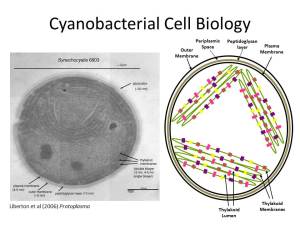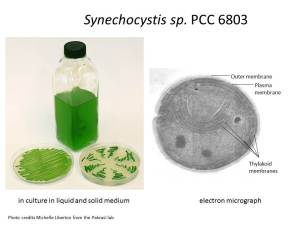Cyanobacteria: Prokaryotic organisms that can perform oxygenic photosynthesis (like plants). Think of them as free-living chloroplasts. These cells do not contain the various organelles that eukaryotic cells (plants and algae) have. Cyanobacteria are Gram negative bacteria, which means they have an outer membrane, a peptidoglycan layer and a plasma membrane. In addition to this double outer membrane system, they have an internal thylakoid membrane system for photosynthesis. The cell sizes of these organisms can vary significantly, but some can be as small as 1 µm in diameter. (Eukaryotic cells, like those of plants and algae, can be 10 – 100 µm.) Cyanobacteria also use the Calvin cycle to fix carbon dioxide in the same way as plants and algae.
Cyanobacterial genomic resources at Cyanobase
Cyanobacterial Cell Biology: A closer look at cyanobacterial cell biology and the relationship among the different membrane systems within cyanobacterial cells.
 This is the simple version of membrane arrangement in cyanobacteria. The real story is more complicated. How the thylakoid membranes are formed, maintained and partitioned (when cells divide) is an area of active research in the cyanobacterial research community. For example, how are the individual thylakoids related? Are they all connected enclosing a single lumenal space? Are the thylakoid membranes physically connected to the plasma membrane? The answers to these fundamental questions of cyano cell biology have significant implications for the photosynthetic protein complexes within the thylakoid membranes, specifically concerning how the numerous components of these enzymes assemble.
This is the simple version of membrane arrangement in cyanobacteria. The real story is more complicated. How the thylakoid membranes are formed, maintained and partitioned (when cells divide) is an area of active research in the cyanobacterial research community. For example, how are the individual thylakoids related? Are they all connected enclosing a single lumenal space? Are the thylakoid membranes physically connected to the plasma membrane? The answers to these fundamental questions of cyano cell biology have significant implications for the photosynthetic protein complexes within the thylakoid membranes, specifically concerning how the numerous components of these enzymes assemble.
Check out these references for more on cyanobacterial membrane architecture and its implications:
http://www.ncbi.nlm.nih.gov/pubmed/16736255
http://www.ncbi.nlm.nih.gov/pubmed/21173021
http://www.ncbi.nlm.nih.gov/pubmed/15611096
http://www.ncbi.nlm.nih.gov/pubmed/23255600
Model Organisms
Synechocystis sp. PCC 6803: The first photosynthetic organism to have its genome sequenced. A commonly used laboratory strain for photosynthetic research. This strain is a great genetic system because it is naturally transformable and performs double homologous recombination. This means that scientists can feed the cells whatever engineered DNA they would like and the cells will take it up and integrate it within the appropriate site in their genome. Therefore, very specific targeted mutations can be introduced and replace the normal (wild-type) genes, all without much fuss. The 6803 strain is also capable of growing in the presence of glucose and the PSII inhibitor DCMU. This is a benefit to photosynthesis researchers that would like to make mutants in the photosynthetic machinery. Because the cells can survive on an alternative carbon source, serious mutations that would otherwise kill the cells can be maintained in the lab. Having DCMU around ensures that the cells are not even trying to be photosynthetic and reduces the pressure on these mutants, which would try to induce secondary mutations to try to compensate for poor photosynthetic activity.

Pingback: The Dangerous Double Life of a Distinctive Diazotroph | New Under The Sun Blog